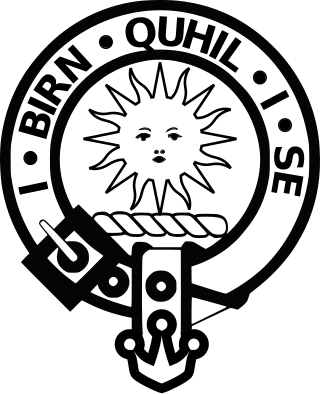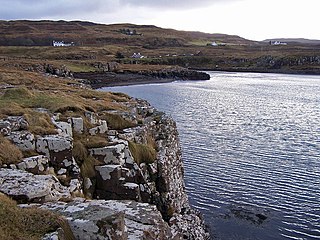
North Uist is an island and community in the Outer Hebrides of Scotland.

The Cuillin is a range of mostly jagged rocky mountains on the Isle of Skye in Scotland. The main Cuillin ridge is also called the Black Cuillin to distinguish it from the Red Cuillin, which lie to the east of Glen Sligachan.

Clan MacLeod is a Highland Scottish clan associated with the Isle of Skye. There are two main branches of the clan: the MacLeods of Harris and Dunvegan, whose chief is MacLeod of MacLeod, who are known in Gaelic as Sìol Tormoid ; the Clan MacLeod of Lewis and Raasay, whose chief is MacLeod of The Lewes, are known in Gaelic as Sìol Torcaill. Both branches claim descent from Leòd, a Norse-Gael who lived in the 13th century.

Dunvegan Castle is located 1 mile (1.6 km) to the north of Dunvegan on the Isle of Skye, off the west coast of Scotland. It is the seat of the MacLeod of MacLeod, chief of the Clan MacLeod. Probably a fortified site from the earliest times, the castle was first built in the 13th century and developed piecemeal over the centuries. In the 19th century the whole castle was remodelled in a mock-medieval style. The castle is built on an elevated rock overlooking an inlet on the eastern shore of Loch Dunvegan, a sea loch.

The Fairy Flag is an heirloom of the chiefs of Clan MacLeod. It is held in Dunvegan Castle along with other notable heirlooms, such as the Dunvegan Cup and Sir Rory Mor's Horn. The Fairy Flag is known for the numerous traditions of celtic fairies, and magical properties associated with it. The flag is made of silk, is yellow or brown in colour, and is a square of side about 18 inches. It has been examined numerous times in the last two centuries, and its condition has somewhat deteriorated. It is ripped and tattered, and is considered to be extremely fragile. The flag is covered in small red "elf dots". In the early part of the 19th century, the flag was also marked with small crosses, but these have since disappeared. The silk of the flag has been stated to have originated in the Far East, and was therefore extremely precious, which led some to believe that the flag may have been an important relic of some sort. Others have attempted to associate the flag with the Crusades or even a raven banner, which was said to have been used by various Viking leaders in the British Isles.

Clan Macdonald of Clanranald, also known as Clan Ranald, is a Highland Scottish clan and a branch of Clan Donald, one of the largest Scottish clans. The founder of the Macdonalds of Clanranald is Reginald, 4th great-grandson of Somerled. The Macdonalds of Clanranald descend from Reginald's elder son Allan and the MacDonells of Glengarry descend from his younger son Donald. The clan chief of the MacDonalds of Clanranald is traditionally designated as The Captain of Clanranald and today both the chief and clan are recognised by the Lord Lyon King of Arms, the heraldic judge in Scotland.

Clan Macdonald of Sleat, sometimes known as Clan Donald North and in Gaelic Clann Ùisdein, is a Scottish clan and a branch of Clan Donald—one of the largest Scottish clans. The founder of the Macdonalds of Sleat was Ùisdean, or Hugh, a 6th great-grandson of Somerled, a 12th-century Lord of the Isles. The clan is known in Gaelic as Clann Ùisdein, and its chief's Gaelic designation is Mac Ùisdein, in reference to the clan's founder. Both the clan and its clan chief are recognised by the Lord Lyon King of Arms, who is the heraldic authority in Scotland.

Clan MacDonald of Keppoch, also known as Clan MacDonellof Keppoch or Clan Ranald of Lochaber, is a Highland Scottish clan and a branch of Clan Donald. The progenitor of the clan is Alistair Carrach MacDonald, 4th great-grandson of the warrior Somerled. The clan chief is traditionally designated as the "Son of Ranald's son".

Clan MacLeod of The Lewes, commonly known as Clan MacLeod of Lewis, is a Highland Scottish clan, which at its height held extensive lands in the Western Isles and west coast of Scotland. From the 14th century up until the beginning of the 17th century there were two branches of Macleods: the MacLeods of Dunvegan and Harris ; and the Macleods of the Isle of Lewis. In Gaelic the Macleods of Lewis were known as Sìol Thorcaill, and the MacLeods of Dunvegan and Harris were known as Sìol Thormoid.

The Dunvegan Cup is a wooden ceremonial cup, decorated with silver plates, which dates to 1493. It was created at the request of Caitríona, wife of John Maguire, lord of Fermanagh. The cup is an heirloom of the Macleods of Dunvegan, and is held at their seat of Dunvegan Castle.

The MacCrimmons is a Scottish family that served as pipers to the chiefs of Clan MacLeod for several generations. The MacCrimmon kindred was centred at Borreraig near the Clan MacLeod seat at Dunvegan on the Isle of Skye. At Borreraig the MacCrimmons conducted one of the best known "piping colleges" in the Highlands of Scotland.

The Battle of the Western Isles was a series of conflicts in 1585 and 1586 on the islands of Jura, Islay, Mull and Tiree, Scotland as well as the peninsula of Kintyre on the mainland. However, although the historic sources describe this as having taken place in the "Western Isles" which are now known as the Outer Hebrides, all of the aforementioned locations are actually in the Inner Hebrides. It was fought between the Clan Macdonald of Sleat and Clan MacDonald of Dunnyveg against the Clan Maclean. In 1585, the Macleans slaughtered a party of the MacDonalds of Sleat when they were mistakenly accused of stealing cattle and the MacDonalds of Sleat and Dunnyveg retaliated. James VI of Scotland intervened but the conflicts continued into 1586. After further intervention an Act of Parliament was passed which would levy fines on any clan chiefs who did not maintain peace and good order among their vassals.

Sir Roderick MacLeod of MacLeod (c1559–1626), also known as Rory MacLeod, was the 15th Chief of Clan MacLeod and one of the most famed and notorious chiefs of that clan.

Sir Rory Mor's Horn is a drinking horn, one of several heirlooms of the MacLeods of Dunvegan, chiefs of Clan MacLeod. Clan custom is that each successive chief is to drink a full measure of the horn in wine to prove his manhood. The artwork on the horn has been dated to the 16th century, and by some as far back as the 10th century. The MacLeod chiefs have several other notable heirlooms kept at Dunvegan Castle, such as the Fairy Flag and the Dunvegan Cup.

The Battle of Carinish was a Scottish clan battle fought in North Uist in 1601. It was part of a year of feuding between Clan MacLeod of Dunvegan and the Clan MacDonald of Sleat, that ended with a MacDonald victory and an enforced peace.
William Dubh MacLeod is considered to be the 7th Chief of Clan MacLeod. He is thought to have been a younger son, yet because of the death of his elder brother, William Dubh succeeded his father, Iain Borb, in the year 1442. William Dubh was an old man when he was killed, leading his clan, at the Battle of Bloody Bay in 1480. He was the last MacLeod chief to be buried on the island of Iona. He was succeeded by his son, Alasdair Crotach.

The Battle of Glendale was fought on the Inner Hebridean Isle of Skye, between the MacDonalds of Sleat and the MacDonalds of Clanranald, against the MacLeods of Harris and Dunvegan and the MacLeods of Lewis. According to MacLeod tradition preserved in the early 19th century, the battle was fought in about the year 1490; yet it has been recently suggested that the battle more likely took place sometime after 1513. MacLeod tradition records that the battle was the 'most tremendous battle' that the clan ever fought—although the clan was victorious, it never fully recovered from its severe losses. MacLeod tradition relates how the MacDonalds originally had the upper hand during the conflict, but when the MacLeod's sacred Fairy Flag was unfurled the MacLeods gained heart and won the battle.

Alasdair Crotach MacLeod is considered to be the 8th Chief of Clan MacLeod. He was the son of the 7th Chief of Clan MacLeod, William Dubh, and succeeded his father in 1480, following William Dubh's death at the Battle of Bloody Bay. He was the first MacLeod chief not to be buried on the island of Iona.
The Chiefs of Clan MacLeod claim descent from Leod, a high-born Norse-Gael who is thought to have lived in the 13th century, but whose ancestors are known from multiple pedigrees at least into the early 12th or late 11th centuries. It is said that the chiefs of the clan have been seated at Dunvegan Castle since the time of Leod, and this on the Isle of Skye where for centuries they were sovereign within their own territories.
Roderick Macleod, also known as Old Rory, was the chief of Clan Macleod of Lewes in the later half of the 16th century.















